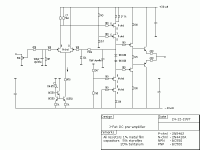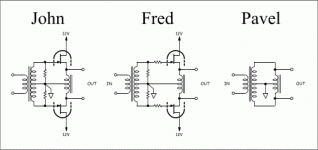john curl said:Anything better to contribute?
Ooo! Ooo! Mr. Kotter! Mr. Kotter! Ooo! Ooo!
An externally hosted image should be here but it was not working when we last tested it.
se
jam said:Damm Steve you beat me to it.....................😀
How about this?
Looks ok. But where's T1?
se
Nelson Pass said:
Not true, I have it on good authority that they were simply
custom labeled, which Motorola also did for Threshold.
If you wanted copper, TI used to make TO-3's like that. I've
got a few, and they are sweeet...
We've done that for at least one high-end CD maker, it makes them feel special.
Pardon my ignorance, but when trying to control a circuit, with respects to stabilizing AC modulation, has anyone ever use a dual wound transformer, as similar to an infinite slope crossover, but use the opposing transformer winding in a opposing fashion..via a transistor load -with a mirrored signal (on that 'side' of the transformer). This would clear the transistor from the signal path and leave the transformer as the only effective device in the path. I'm not a circuit guy, I'm just musing a bit. Ah, I'm sure it's done in some place, somewhere. I realize that's a lot like tube circuitry, but I mean it in a slightly different way.
KBK said:Pardon my ignorance, but when trying to control a circuit, with respects to stabilizing AC modulation, has anyone ever use a dual wound transformer, as similar to an infinite slope crossover, but use the opposing transformer winding in a opposing fashion..via a transistor load -with a mirrored signal (on that 'side' of the transformer). This would clear the transistor from the signal path and leave the transformer as the only effective device in the path.
I'm not quite following you here. Could you scribble a simple schematic to illustrate?
se
Using the modulation in the one side of the transformer as the control point of a servo, via actively driving the other side with a mirrored signal. Something like that. If you think about it, you can actually create a fully modulated pathway via transistor controlled transformers,and never have a transistor in the path at all,other than base junctions for monitoring the given signal point.. You just have to start with a pretty chunky signal. Ah, just thinking out loud.
It's the same thinking that tells me that one can have a phase perfect passive crossover for loudspeakers, but you have to be willing to throw away a minimum of half your power for crowbaring the signal in the phase domain. How much energy is left to control the woofer and like is debatable, but it can be done. It just goes against what people normally think. Active preamp signals are likely easier to work with, in that single respect, where the dynamic stability of loudspeakers is a nightmare. I dunno. Just musing out loud.
It's the same thinking that tells me that one can have a phase perfect passive crossover for loudspeakers, but you have to be willing to throw away a minimum of half your power for crowbaring the signal in the phase domain. How much energy is left to control the woofer and like is debatable, but it can be done. It just goes against what people normally think. Active preamp signals are likely easier to work with, in that single respect, where the dynamic stability of loudspeakers is a nightmare. I dunno. Just musing out loud.
Some people will do things the hard way, when IC's do it very well, cheaply, and with a small footprint.
But if you use transistor controlled transformers in place of transistors themselves, you get a circuit where no direct active component is in there at all. Surely there is benefit to that. However different to implement and figure out. Depending on implementation, it would also be kind of hard to pass DC. I mean the transformer is stacked on top of the transistor, in effect, but the transistor becomes absent with regards to a notable part of it's sonic additions to the whole shebang. Maybe. You'd have to try it.
Could be an interesting result. Might be fun to go through the exercise.
Could be an interesting result. Might be fun to go through the exercise.
john curl said:Some people will do things the hard way, when IC's do it very well, cheaply, and with a small footprint.
Years ago when I was less than 5ft tall our family had a really smart Blue Heeler / Labrador cross-called Susy. I took her for a walk in the park one day and asked “what’s that up in the tree?”.
She astutely replied “BARK! BARK!”.
It's true

KBK said:But if you use transistor controlled transformers in place of transistors themselves, you get a circuit where no direct active component is in there at all. Surely there is benefit to that. However different to implement and figure out. Depending on implementation, it would also be kind of hard to pass DC. I mean the transformer is stacked on top of the transistor, in effect, but the transistor becomes absent with regards to a notable part of it's sonic additions to the whole shebang. Maybe. You'd have to try it.
Well, if the transistor's controlling the transformer, then the transistor is ultimately still there.
A transformer by the way can give you voltage gain without any transistors at all.
se
PMA said:Or current gain 😉 .
Quite so. Though of course not at the same time. 😀
No active device amplifier, you remember, Steve?
Mmmm. Actually, no, I don't. Care to refresh my memory?
se
You mean transistors can do both current and voltage gain at the same time ? 
(makes you wonder how tall Mr Kleinschmidt is nowadays, no)

(makes you wonder how tall Mr Kleinschmidt is nowadays, no)
jacco vermeulen said:(makes you wonder how tall Mr Kleinschmidt is nowadays, no)
73 inches.
Steve Eddy said:
Mmmm. Actually, no, I don't. Care to refresh my memory?
se
Sure. ZTAS (zero transistor amplifying stage). It was in another place. Today I would solve it as complementary-symmetrical topology.
Attachments
PMA said:solve it as complementary-symmetrical topology.
Got a drawing ?
(it's true folks, Mr K. even posted pics of his doppelganger, bit skinny though)
- Status
- Not open for further replies.
- Home
- Amplifiers
- Solid State
- John Curl's Blowtorch preamplifier

